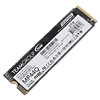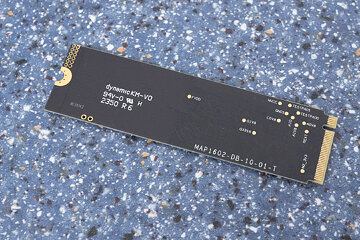 17
17
Team Group MP44Q 2 TB Review
(17 Comments) »Introduction

Team Group is a well-known Taiwanese hardware manufacturer with a long history of catering to the needs of enthusiasts and gamers from all over the globe. Their lineup includes DRAM memory and solid-state drives, and Team Group also offer various memory cards and USB thumb drives.

The MP44Q from Team Group is designed to be cost-effective. To achieve that, it uses the Maxiotech MAP1602 controller, which has been delivering outstanding performance at great pricing in well known drives like the Lexar NM790. Unlike the NM790, which uses YMTC TLC NAND flash, the Team Group MP44Q comes with YMTC QLC flash, in the 232-layer variant. This gives Team Group an additional cost advantage vs using TLC. As expected for a value-oriented SSD, a DRAM cache chip is not available, but the SSD will use up to 40 MB of system memory through the HMB (Host-Memory-Buffer) mechanism.
The Team Group MP44Q is available in capacities of 1 TB ($60), 2 TB ($120) and 4 TB ($235). The endurance is set to 512 TBW, 1024 TBW, and 2048 TBW respectively. Team Group includes a five-year warranty with the MP44Q SSD.
| Specifications: Team Group MP44Q 2 TB SSD | |
|---|---|
| Brand: | Team Group |
| Model: | TM8FFD002T0C101 |
| Capacity: | 2048 GB (1907 GB usable) No additional overprovisioning |
| Controller: | Maxiotech MAP1602A |
| Flash: | YMTC 232-Layer 3D QLC Rebranded as ATQYB122C0HGAA |
| DRAM: | N/A, but 40 MB HMB |
| Endurance: | 1024 TBW |
| Form Factor: | M.2 2280 |
| Interface: | PCIe Gen 4 x4, NVMe 1.4 |
| Device ID: | TEAM TM8FFD002T |
| Firmware: | SN15772 |
| Warranty: | Five years |
| Price at Time of Review: | $120 / $59 per TB |
Packaging
The Drive
The drive is designed for the M.2 2280 form factor, which makes it 22 mm wide and 80 mm long.
PCI-Express 4.0 x4 is used as the host interface to the rest of the system, which doubles the theoretical bandwidth compared to PCIe 3.0 x4.
On the PCB you'll find the SSD controller and four flash chips. A DRAM cache is not available.
As heat spreader Team Group is using the sticker. It is somewhat metallic with a gray substance at the back, which according to Team Group is Graphene, but it could also be graphite based on the looks. The sticker is somewhat stiff, but not as stiff as heatspreaders with a copper core. Please also note that the heat spreader is rather thin.
Chip Component Analysis
MaxioTech's MAP1602A controller is produced on TSMC's 12 nanometer node and uses several Arm Cortex R5 CPU cores.
The four flash chips are YMTC 232-layer 3D QLC NAND. Each chip has a capacity of 512 GB.
Test Setup
| Test System SSD 2024 | |
|---|---|
| Processor: | Intel Core i9-13900KS Raptor Lake 6.0 GHz, 8+16 cores / 32 threads |
| Motherboard: | ASUS ROG Z790 Dark Hero BIOS 1102 |
| Memory: | 2x 16 GB DDR5-6000 |
| Graphics: | PNY GeForce RTX 4080 Super Verto OC |
| Cooling: | Valkyrie Syn 360 mm AIO |
| Thermal Paste: | Arctic MX-6 |
| Power Supply: | Thermaltake Toughpower GF3 850 W ATX 3.0 / 16-pin 12VHPWR |
| Case: | darkFlash DRX70 White |
| Operating System: | Windows 11 Professional 64-bit 23H2 VBS enabled (Windows 11 default) |
| Drivers: | NVIDIA: 552.12 WHQL |
Synthetic Testing
- Tests are run with a 20-second-long warm-up time (result recording starts at second 21).
- Between each test, the drive is left idle for 60 seconds, to allow it to flush and reorganize its internal data.
- All write requests contain random, incompressible data.
- Disk cache is flushed between all tests.
- During these tests, M.2 drives are tested with additional active fan-cooling, to ensure thermal throttling can't happen
Real-life Testing
- After initial configuration and installation, a disk image is created; it is used to test every drive.
- Automated updates are disabled for the OS and all programs. This ensures that—for every review—each drive uses the same settings, without interference from previous testing.
- Our disk image consumes around 700 GB—partitions are resized to fill all available space on the drive.
- All drives are filled with random data to 85% of their capacity. This is intentional, to run the drive in realistic operating conditions—nobody uses a nearly-empty SSD in their system. It also puts additional stress on the pseudo-SLC cache subsystem, because there is less free NAND space to work with.
- Partitions are aligned properly.
- Disk cache is flushed between all tests.
- In order to minimize random variation, each real-life performance test is run several times, with reboots between tests to minimize the impact of disk cache.
- All application benchmarks run the actual application and do not replay any disk traces.
- Our real-life testing data includes performance numbers for a typical high-performance HDD, using results from a Western Digital WD Black 1 TB 7200 RPM 3.5" SATA. HDDs are significantly slower than SSDs, which is why we're not putting the result in the chart, as that would break the scaling, making the SSDs indistinguishable in comparison. Instead, we've added the HDD performance numbers in the title of each test entry.
- During these tests, M.2 drives are tested with additional active fan-cooling, to ensure thermal throttling can't happen
Our Patreon Silver Supporters can read articles in single-page format.
Mar 28th, 2025 03:31 EDT
change timezone
Latest GPU Drivers
New Forum Posts
- TPU's Nostalgic Hardware Club (20135)
- Microprose: Falcon 5.0 - Well under development- yeay (4)
- What are you playing? (23283)
- The TPU UK Clubhouse (25983)
- Post your Speedtest.net Speeds! (2355)
- Smelly brand new graphic cards? Remanufactured? (14)
- Your PC ATM (35294)
- Gigabyte graphic card - TIM GEL application failure? (11)
- Sexy Mechanical Keyboard Thread (504)
- Problem with Trottlestop and HWINFO64 on MSI Raider 18 (28)
Popular Reviews
- Sapphire Radeon RX 9070 XT Pulse Review
- Samsung 9100 Pro 2 TB Review - The Best Gen 5 SSD
- Assassin's Creed Shadows Performance Benchmark Review - 30 GPUs Compared
- Pulsar Feinmann F01 Review
- ASRock Phantom Gaming B860I Lightning Wi-Fi Review
- be quiet! Pure Rock Pro 3 Black Review
- Sapphire Radeon RX 9070 XT Nitro+ Review - Beating NVIDIA
- ASRock Radeon RX 9070 XT Taichi OC Review - Excellent Cooling
- AMD Ryzen 7 9800X3D Review - The Best Gaming Processor
- ASUS ProArt X870E-Creator Wi-Fi Review
Controversial News Posts
- AMD RDNA 4 and Radeon RX 9070 Series Unveiled: $549 & $599 (260)
- MSI Doesn't Plan Radeon RX 9000 Series GPUs, Skips AMD RDNA 4 Generation Entirely (142)
- Microsoft Introduces Copilot for Gaming (123)
- AMD Radeon RX 9070 XT Reportedly Outperforms RTX 5080 Through Undervolting (118)
- NVIDIA Reportedly Prepares GeForce RTX 5060 and RTX 5060 Ti Unveil Tomorrow (115)
- Over 200,000 Sold Radeon RX 9070 and RX 9070 XT GPUs? AMD Says No Number was Given (100)
- NVIDIA GeForce RTX 5050, RTX 5060, and RTX 5060 Ti Specifications Leak (96)
- Retailers Anticipate Increased Radeon RX 9070 Series Prices, After Initial Shipments of "MSRP" Models (90)


















